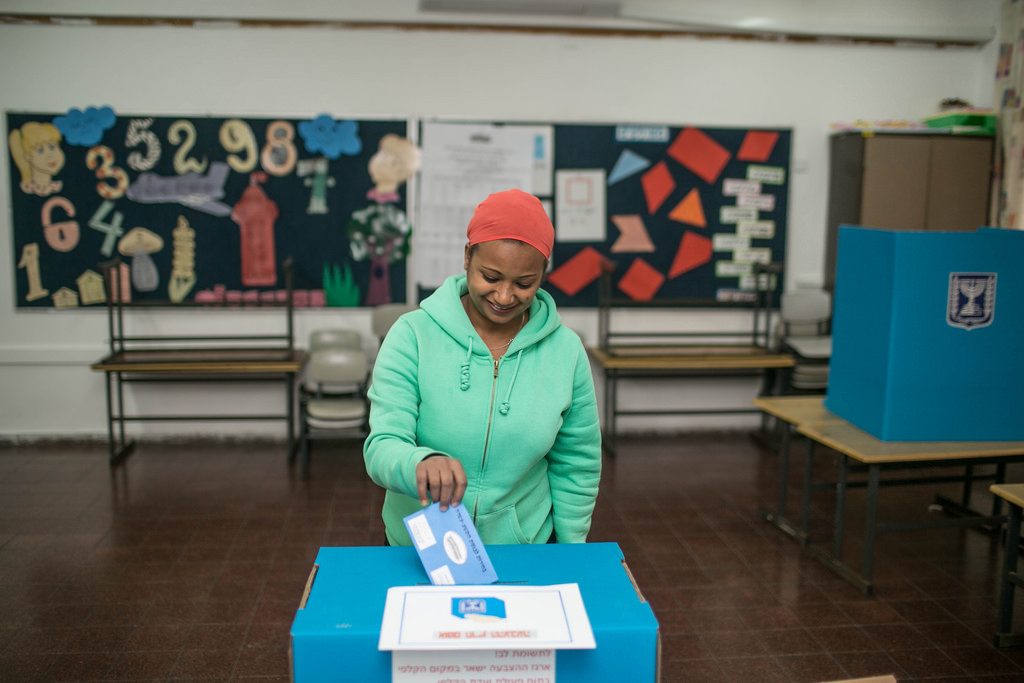FRESH AIR
Israeli election campaign update
February 22, 2019 | Ahron Shapiro

Following our last update on February 7 on the developments in the election campaign, as of February 21, the deadline has passed for political parties to submit their slate of candidates for the April 9 elections. A record 47 parties have registered for the election, while the deadline set off a spate of last-minute mergers and split-offs. According to the Times of Israel, the record number of slates represents almost double the 24 parties that ran in 2015 and outdid 2013’s then-record of 34.
The most complete official list of parties and candidates that will be running for Knesset has been posted online by Ha’aretz (registration required).
This blog, while not updating every single one of the 47 parties in the running, will look at some of the highlights of Israel’s election campaign since the last update, particularly in light of the events of the last few days.
Merger fever: The dilemma
Yesterday – Thursday, February 22 – was the deadline for parties running for Knesset to submit a list of candidates. For this reason, there was an incredibly large amount of merger talk among parties mid-sized and small, for different reasons, and for some others, tough decisions to withdraw from the campaign trail. While certain parties decided to withstand the pressure to merge and run on a principled, disciplined platform, for many others the cost/benefit analysis left difficult choices:
The mid-sized parties: Parties such as like Benny Gantz’ Hosen L’Yisrael (“Resilience for Israel”) and Yair Lapid’s Yesh Atid (“There is a Future”) had been facing polling data that showed that neither party had a chance of becoming the largest Knesset party after the election on their own, and therefore would have been at a disadvantage to the leading Likud party when it comes time to forming a coalition. Indeed, initially the same polls showed that even combined, it was unclear whether they could pass the Likud’s projected number of seats. Yet talk of merger was rampant, if only because the new dynamic might break through a glass ceiling of sorts for each party and attract new voters through momentum.
The small parties: An assortment of parties, both from the political right and left, have been polling close to the minimum threshold of 3.25% to get a Knesset seat. If these parties fail to enter the Knesset, their vote is wasted. On both the right and left, the larger parties want to avoid a situation where votes that would help them form a coalition with their natural partners.
Merger fever: The outcome
Blue and White: On February 21, Resilience for Israeland Yesh Atid announced a united party named Blue and White(“Kachol v’Lavan”) – the colours of the Israeli flag. Under the deal, Party leaders Gantz and Lapid would serve as prime ministers on a pre-set rotation basis – Gantz going first and for longer, Lapid to be Foreign Minister and taking over afterwards. In related party news, Blue and White further burnished its credentials as a security-oriented party by announcing that Gabi Ashkenazi, another former IDF Chief of Staff, would also be joining their list, reversing Ashkenazi’s earlier decision not to run for the Knesset this year. Ashkenazi’s addition creates the unprecedented situation where three out of the first four names on the Blue and White party’s list are former heads of the IDF – Lapid being the odd man out. Earlier, on February 16, Gantz’s faction made further progress towards a goal of bringing left-leaning voters into its every-growing tent by wooing Histadrut Labor Union chairman Avi Nissenkorn to its list. Snap polls by Israel’s Channel 12 and 13 conducted after the announcement of the merger determined that Blue and White would easily overtake the Likud as the Knesset’s largest party if an election were held today.
Jewish Home controversially opens a bigger tent: Facing polls that suggested that none of the small right-wing parties were assured of passing the electoral threshold, the Jewish Home party – since losing its leadership to the New Right party, essentially the National Religious Party of old in all but the name – was pressured by Prime Minister Binyamin Netanyahu to accept a merger with smaller far-right factions to help their chances of crossing the electoral threshold. On Wednesday, Jewish Home capitulated, and controversially accepted a merger with the far-right National Union and extremist Otzma Yehudit – a party unlikely to cross the electoral threshold on its own – which has been compared to assassinated demagogue Rabbi Meir Kahane’s Kach party, which has been barred from participating in elections since 1988 on grounds of racism against Arabs and the party’s offshoots banned from later elections. In return for the “favour”, Netanyahu promised Jewish Home a reserved seat for one of its MKs on the Likud’s list. It’s an unusual move, and has raised legal and legitimacy questions, according to the Times of Israel
Netanyahu’s promise to give Jewish Home a spot on Likud’s slate has faced legal challenges from both inside and outside his party, with activists and legal experts questioning the legitimacy of a political party promising to hand over its votes to a candidate of a different party.
Arab Joint List splits in two: After much speculation, the final Arab party lists submitted at the deadline showed last Knesset’s Joint List had broken in two: the communist Arab-Jewish Hadash party led by Ayman Odeh agreed to run together with Ahmed Tibi’s Arab Movement for Renewal (Ta’al); while the smaller Balad and United Arab List (Ra’am) parties are running together, but separately. It is expected that the split parties will end up competing for approximately the same number of Knesset seats as in the last election, in any case.
Resisting merger: Going it alone
Likud: Besides offering a spot on its list to the Jewish Home party under strange circumstances, the Likud is seeing minor retreats from its polling highs after its primary in early February. Of interest to Australians, MK Sharren Haskell, who once lived in New South Wales and was at risk of being dropped from the Likud’s realistic seat list, was eventually named to the 29th position on the slate (reserved for a woman), a realistic, if not safe position.
Labor and Meretz: After a short bounce following its primary to choose its Knesset list, Avi Gabbai’s party has again dipped in the polls and is currently projected to pass the electoral threshold by only a relatively small margin. While it flirted until the last minute with the idea of running together with the hard-left Meretz party, Labor ultimately decided against it. Labor and Meretz currently poll virtually neck-and-neck, though, of the two, Labor is seen as having more potential for expanding its voter base.
Gesher: Headed by MK Orly Levy-Abekasis, daughter of former Likud Foreign Minister David Levy, Gesher is a new party that focuses on political reform on domestic issues. Despite being wooed by Gantz’s party and facing an uncertain future, the party is pressing ahead alone to the polls with a social justice-minded list that has a chance of resonating with some voters.
United Torah Judaism (UTJ): As reported in our last update, the Ashkenazic Haredi party UTJ has decided to remain a united party, running on its own. An interesting development is that the party declared on February 21 that it would not support a government led by Gantz and Lapid – the latter politician long considered to be a political adversary of the ultra-Orthodox. Whether that resolve would falter in the case of a Blue and White landslide win remains to be seen.
Shas: The Sephardic ultra-Orthodox party led by Aryeh Deri, like its Ashkenazic counterpart has also lined up against Lapid.
Yahad: Exiled Shas leader Eli Yishai ultimately resisted offers of a ministry in the next government if he withdrew his own version of the Shas party, Yahad, from the race. Yishai’s chances of getting over the threshold appear slim at this time.
Kulanu:Despite the fact that many polls show his party failing to cross the electoral threshold, Moshe Kahlon has resisted suggestions to return to his former party, Likud, and is, once gain, running his own list.
Yisrael Beitenu: Former Defence Minister Avigdor Lieberman’s right-wing party, running under the slogan “we won’t be cowed”, is currently projected to barely cross the electoral threshold. Of some surprise to observers, the final candidate list left out several MKs that had served in the party for many years.
New splitoff – new developments
The New Right: On February 20, the breakaway party from Jewish Home, “The New Right”, led by Education Minister Naftali Bennett and Justice Minister Ayelet Shaked announced its Knesset list. Of particular interest is former Jerusalem Posteditor and columnist Caroline Glick, who was sixth on their list – considered to be a safe seat.
Bowing out
Tzipi Livni retires: On February 19, facing polls that showed her Hatenuah (“The Movement”) party failing to cross the electoral threshold and unable to find a party to merge with, Tzipi Livni ended her campaign and announced her retirement from a career in politics that spanned decades and as late as the 2009 election left her a hair’s breadth from the Prime Minister’s office.























